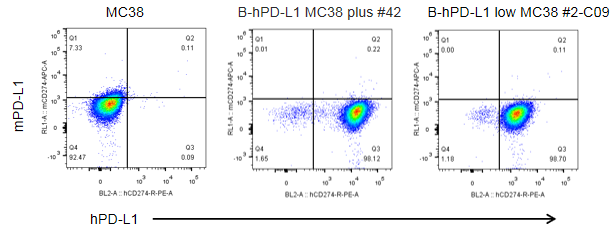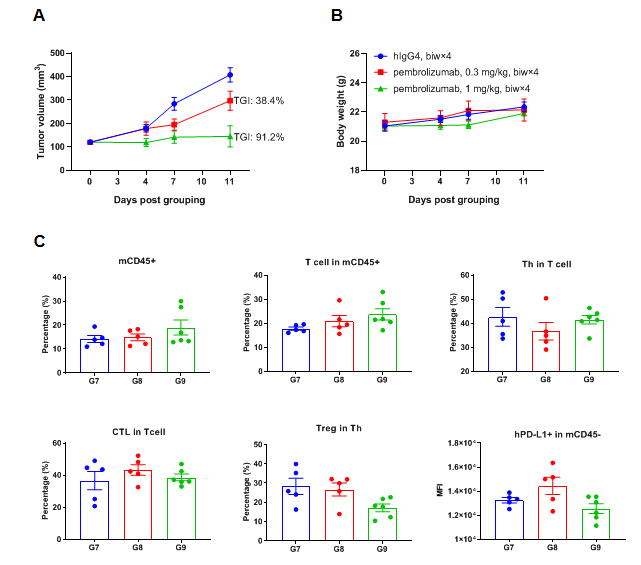B-hPD-L1 low MC38
|
Common name |
B-hPD-L1 low MC38 | Catalog number | 310889 |
| Aliases | CD274, PDCD1L1 | Disease | Colon carcinoma |
|
Organism |
Mouse |
Strain | C57BL/6 |
| Tissue types | Colon | Tissue | Colon |
Description
The mouse Pdl1 gene was replaced by human PD-L1 coding sequence in B-hPD-L1 low MC38 cells. Human PD-L1 is expressed on the surface of B-hPD-L1 low MC38 cells.
Application
Gene targeting strategy for B-hPD-L1 low MC38 cells. The exogenous promoter and human PD-L1 coding sequence was inserted to replace part of murine exon 3. The insertion disrupts the endogenous murine Pdl1 gene, resulting in a non-functional transcript.

PD-L1 expression analysis in B-hPD-L1 low MC38 cells by flow cytometry. Single cell suspensions from wild-type MC38, B-hPD-L1 MC38 plus and B-hPD-L1 low MC38 cultures were stained with species-specific anti-PD-L1 antibody. Mouse PD-L1 was detectable in wild-type MC38 cells. Human PD-L1 was detectable in B-hPD-L1 low MC38 cells, and human PD-L1 was expressed highly on the surface of B-hPD-L1 MC38 plus cells. The 2-C09 clone of B-hPD-L1 low MC38 cells was used for in vivo experiments.

Subcutaneous homograft tumor growth of B-hPD-L1 low MC38 cells. B-hPD-L1 low MC38 cells (1x106) and wild-type MC38 cells (1x106) were subcutaneously implanted into C57BL/6 mice (female, 6-week-old, n=5). Tumor volume and body weight were measured twice a week. (A) Average tumor volume ± SEM. (B) Body weight (Mean± SEM). Volume was expressed in mm3 using the formula: V=0.5 X long diameter X short diameter2. As shown in panel A, B-hPD-L1 low MC38 cells were able to establish tumors in vivo and can be used for efficacy studies.
The subcutaneous tumor formation of B-hPD-L1 low MC38 cells was slow, and the inoculation dose was recommended to be increased to 1x106.

Antitumor activity of anti-human PD-1 antibody (pembrolizumab, in house) in B-hPD-1/hPD-L1 mice. (A) Anti-human PD-1 antibody inhibited MC38 tumor growth in B-hPD-1/hPD-L1 mice. Murine colon cancer B-hPD-L1 low MC38 cells were subcutaneously implanted into homozygous B-hPD-1/hPD-L1 mice (female, 7-week-old, n=6). Mice were grouped when tumor volume reached approximately 100-150 mm3, at which time they were treated with anti-human PD-1 antibody indicated in panel. (B) Body weight changes during treatment. (C) TILs analysis from tumor tissue. Results showed that anti-human PD-1 antibody was efficacious in controlling tumor growth in B-hPD-1/hPD-L1 mice, demonstrating that the B-hPD-1/hPD-L1 mice provide a powerful preclinical model for in vivo evaluation of anti-human PD-1 antibodies. Values are expressed as mean ± SEM.











